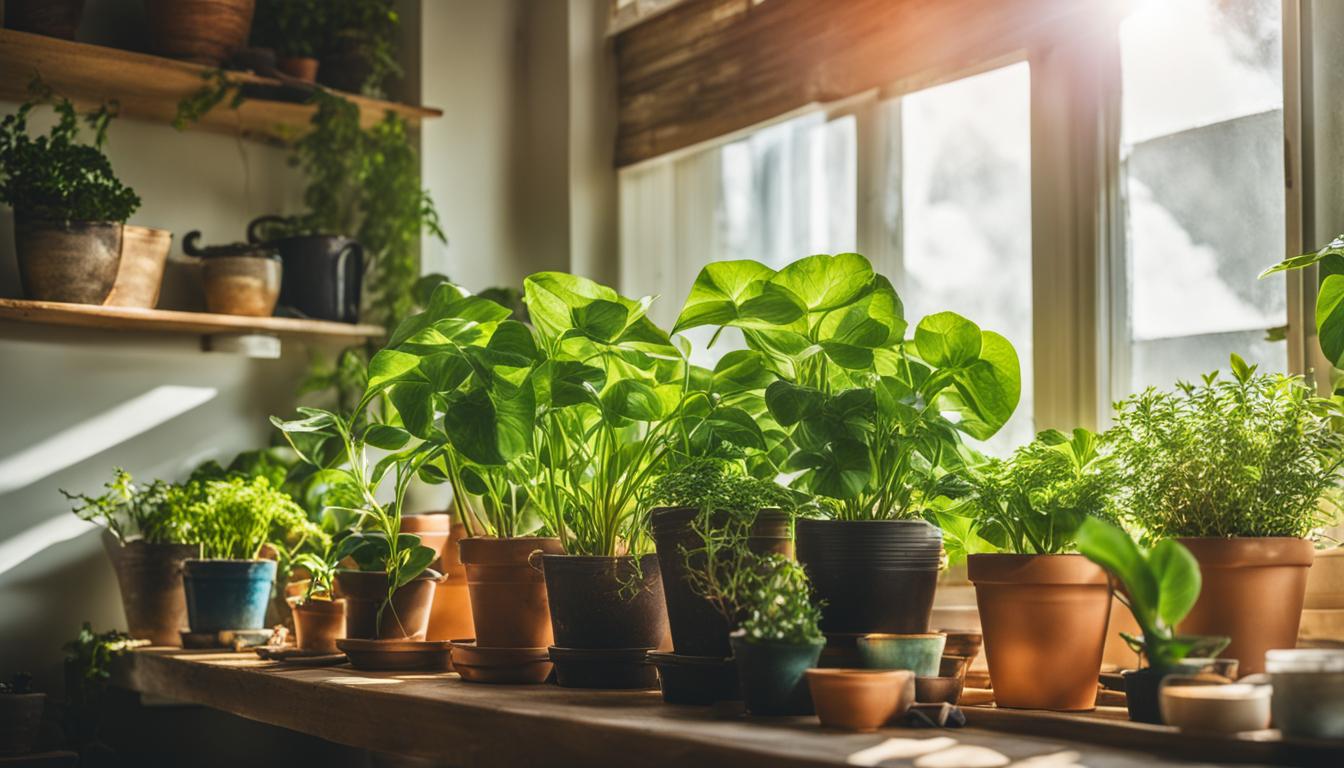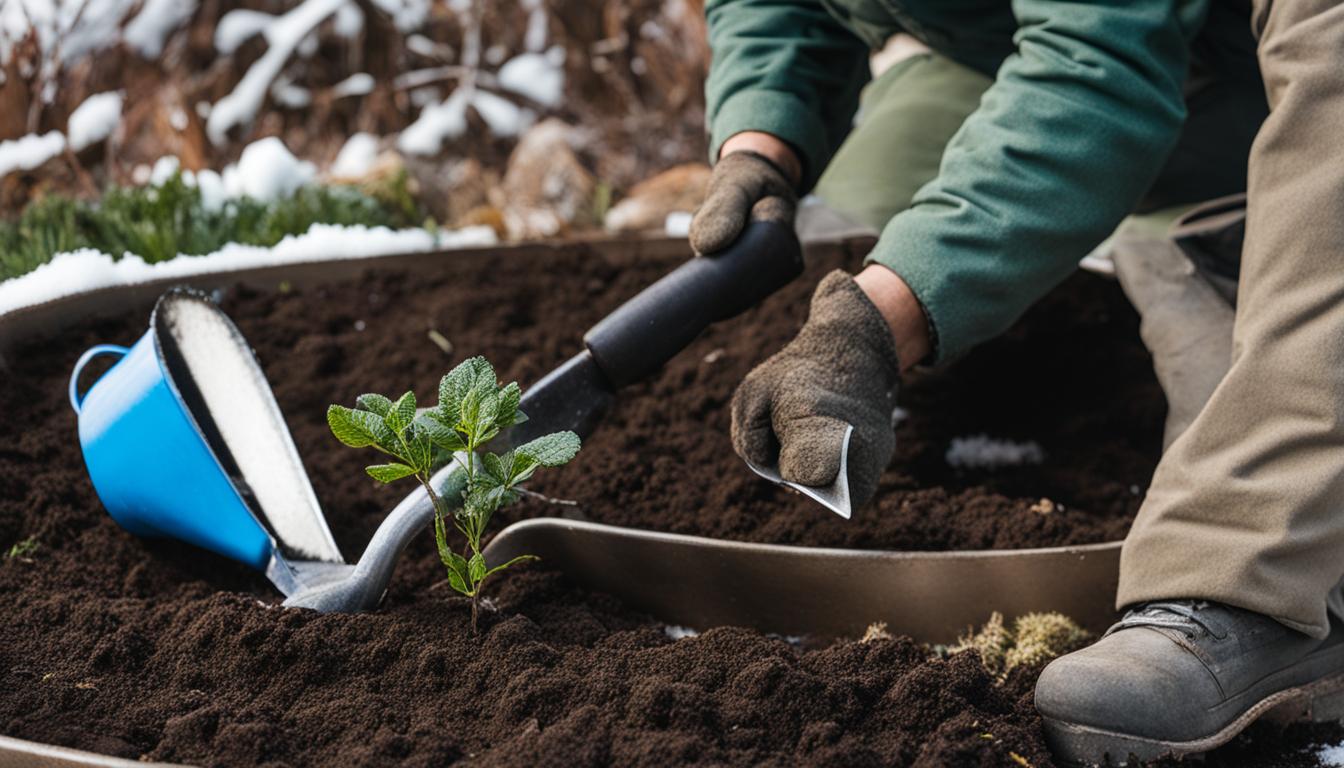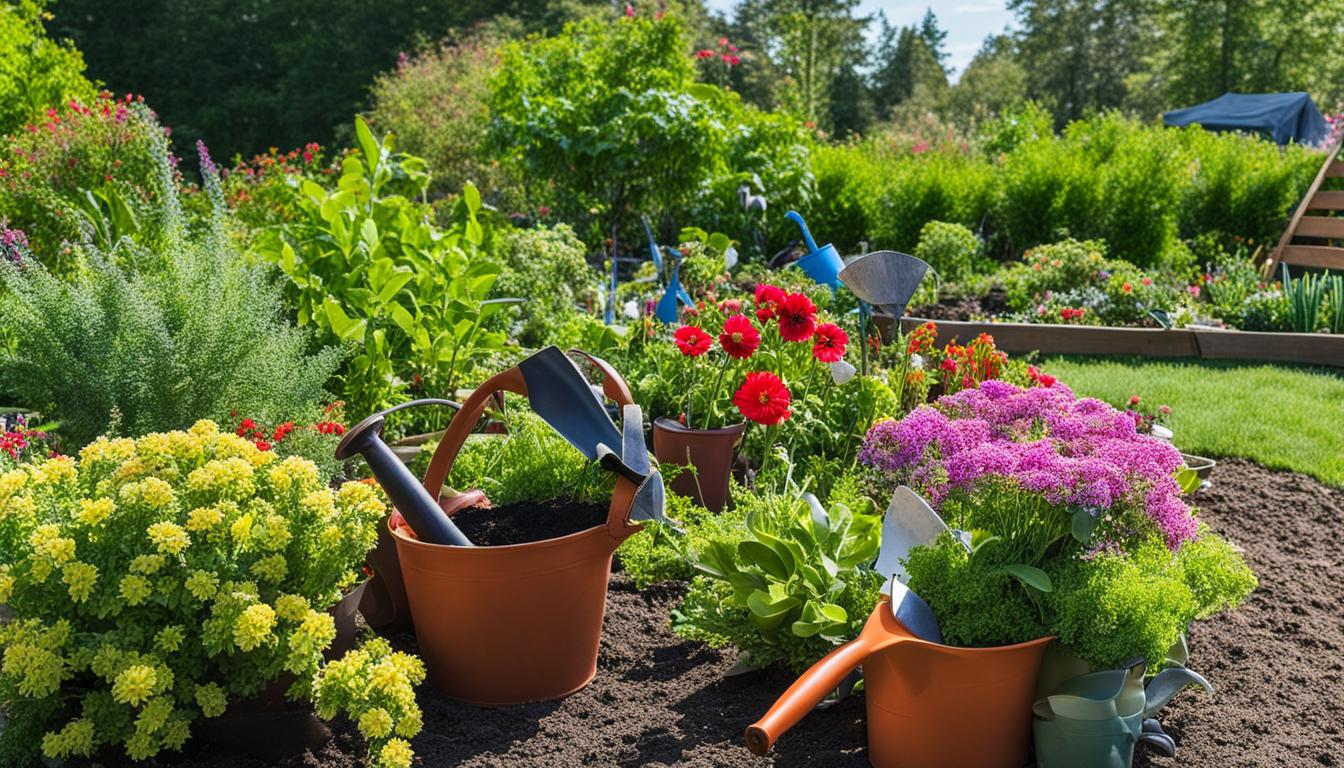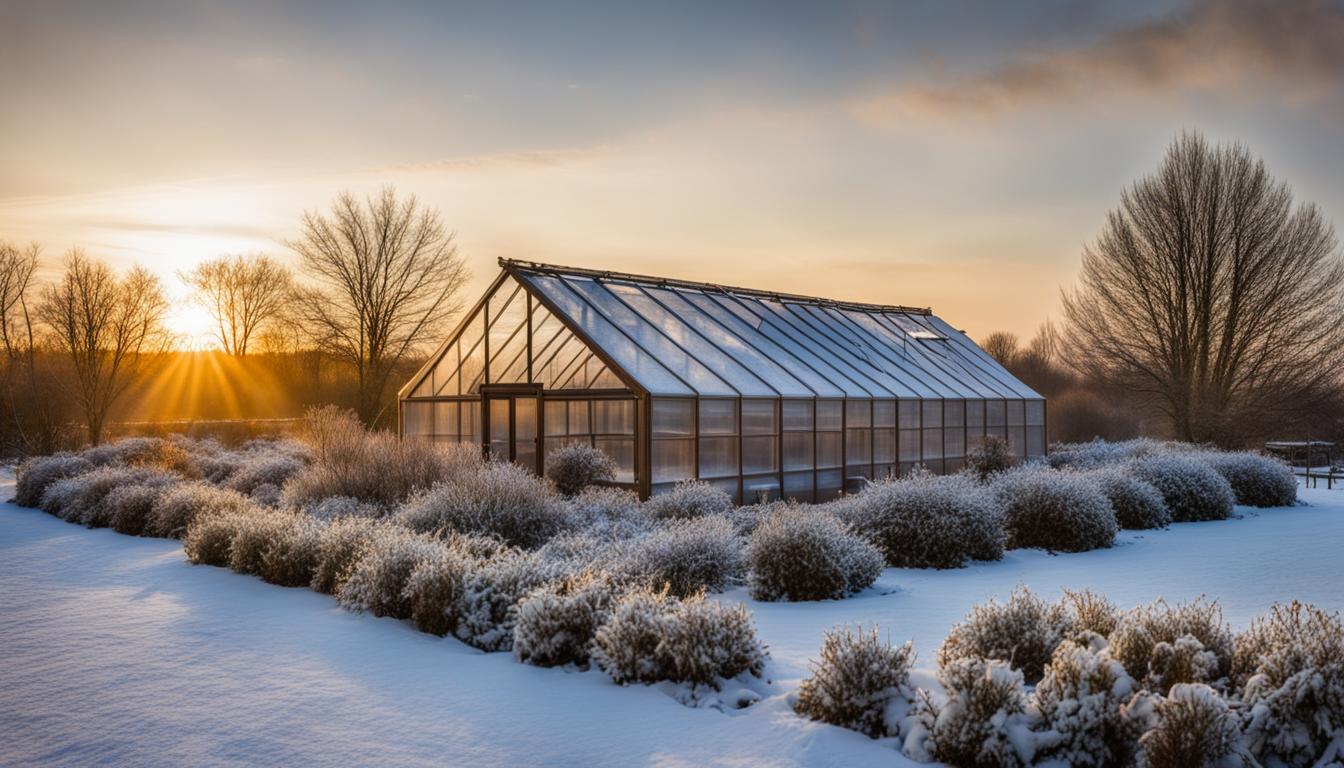As a gardening enthusiast, I’m excited to share my top gardening tips for fall. With autumn already here, it’s time to equip yourself with seasonal gardening tips to prepare your garden for fall. In this article, I will provide you with all the necessary fall gardening ideas, fall planting tips, and fall garden care tips to keep your garden thriving even in the colder months.
Preparing for fall should ideally begin in late summer, but it’s never too late to start. Whether you’re an experienced gardener or just starting, these tips will help you assess your garden’s needs, clean up summer debris, plant fall bulbs, choose the right plants, protect your plants from frost, prune and divide perennials, take care of your lawn, mulch and protect garden beds, and enjoy fall colors and lasting beauty.
Throughout this article, you’ll find valuable information and insights that will help you create and maintain your fall garden. By using these tips, you’ll be able to enjoy autumn blooms, extend your vegetable harvest, and ensure your garden stays healthy and beautiful throughout the season.
So, let’s dive in and discover my top gardening tips for fall!
Assessing Your Garden’s Needs for Fall
Fall is a beautiful season, but it can be a challenging time for gardeners. As the temperatures drop, plants require different types of care in order to stay healthy and thrive.
Before you start preparing your garden for fall, it’s important to assess its needs. Here are some tips to help you get started:
- Take inventory of your plants: Walk around your garden and take note of what you have growing. Make a list of the plants that will need special attention during the fall.
- Evaluate your soil: Check your soil’s pH level to ensure it’s in the optimal range for fall planting. If it’s too acidic or alkaline, you may need to amend it with compost or other organic matter.
- Consider your climate: Different regions have different climate patterns, which affect the types of plants that thrive in the fall. Research which plants are best suited for your climate, and plan accordingly.
- Assess your garden’s drainage: Fall can bring heavy rains, which can lead to waterlogged soil and root rot. Check your garden’s drainage to ensure water can flow freely away from your plants.
- Look for signs of pests and disease: Fall is the time when pests and diseases can take hold and damage your plants. Look for any signs of infestation or disease, and take action as needed.
By taking the time to assess your garden’s needs, you’ll be better prepared to care for it throughout the fall season.
Cleaning Up Summer Debris
As the summer comes to an end, it’s essential to clean up any debris left behind to keep the garden tidy and prepare it for autumn. Removing dead plants and preparing the soil for planting are critical steps in getting your garden ready for fall.
Start by removing any dead branches, leaves, and debris that may have accumulated in the garden over the summer. This debris can be a hiding spot for pests and diseases that can harm your plants. It’s best to remove them before they cause any damage.
When removing plants, be sure to dispose of them properly. If they are healthy, they can be added to a compost pile. However, if they are diseased, it’s best to remove them from your property entirely to prevent the spread of disease.
After removing debris, it’s time to prepare the soil. You can use a garden fork or tiller to loosen the soil and remove any weeds. Adding compost or other organic matter to the soil will help to improve its quality and provide the necessary nutrients for the plants.
If you have a vegetable garden, be sure to remove any old plants and add compost to the soil. This will help to replenish the nutrients and improve the soil quality, allowing for more bountiful harvests.
Tools Needed:
- Garden gloves
- Pruning shears
- Garden fork or tiller
- Compost or organic matter
“Cleaning up summer debris is an essential step in preparing your garden for fall. It not only helps to keep your garden looking neat but also prepares the soil for planting and protects your plants from pests and diseases.” – Garden Expert
By following these fall gardening tips and cleaning up summer debris, you can ensure the health of your plants and a beautiful autumn landscape.
Planting Fall Bulbs for Vibrant Spring Blooms
Fall is the perfect time to plant bulbs for a colorful spring garden. There’s nothing quite like the feeling of seeing those first blooms after a long winter! Here are some fall planting tips to ensure your spring garden is vibrant and colorful:
- Choose the right bulbs: When selecting bulbs, look for ones that are plump and firm without any cracks or blemishes. Tulips, daffodils, and crocuses are all great options for fall planting.
- Prepare the soil: The soil should be well-draining and loose. Add a layer of compost or other organic material to improve soil quality.
- Plant at the right depth: A general rule of thumb is to plant bulbs at a depth that’s two to three times the height of the bulb. Make sure to follow the specific instructions for the bulbs you’re planting.
- Choose the right location: Most bulbs prefer full sun to partial shade. Make sure to plant them in an area with enough sunlight at the appropriate time of day.
- Water thoroughly: After planting, water the bulbs deeply to ensure the soil is thoroughly moistened.
- Add a layer of mulch: Adding a layer of mulch on top of the soil can help regulate soil temperature and moisture levels, protecting the bulbs as they establish their roots.
| Bulb Type | Planting Depth | Spacing |
|---|---|---|
| Tulips | 6-8 inches | 4-6 inches apart |
| Daffodils | 6-8 inches | 4-6 inches apart |
| Crocuses | 3-4 inches | 2-3 inches apart |
In just a few easy steps, you can plant fall bulbs for a beautiful, colorful spring garden. Don’t forget to mark where you planted the bulbs so you don’t accidentally dig them up in the spring!
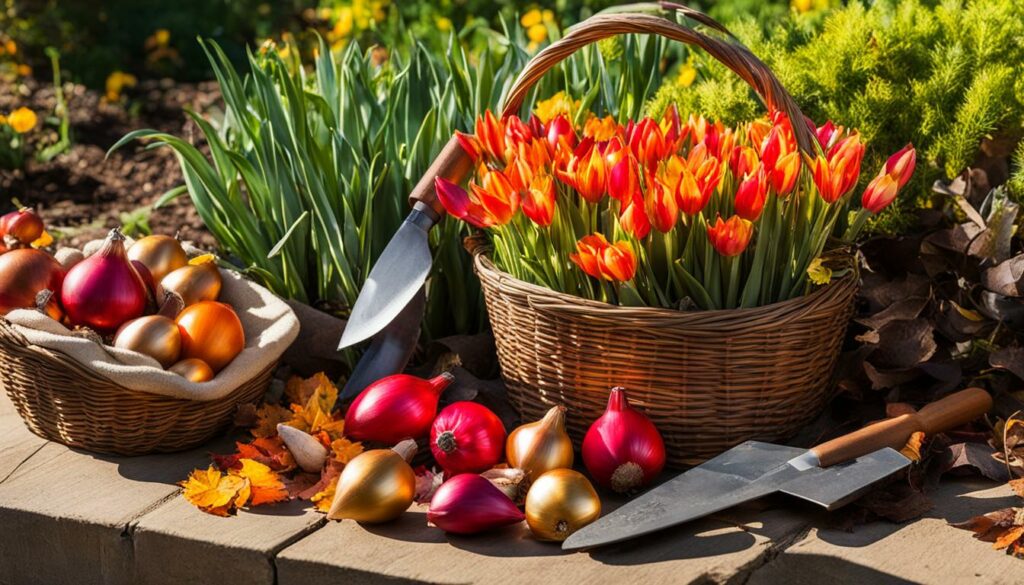
Choosing the Right Plants for Fall
Fall gardening is all about choosing the right plants that can handle cooler temperatures and shorter days. Here are some of my top picks for the best plants for fall gardening:
| Plant Name | Plant Type | Best Growing Conditions |
|---|---|---|
| Chrysanthemums | Perennials | Full Sun to Partial Shade |
| Pansies | Annuals | Full Sun to Partial Shade |
| Kale | Vegetable | Full Sun to Partial Shade |
| Aster | Perennials | Full Sun to Partial Shade |
| Goldenrod | Perennial | Full Sun |
Chrysanthemums are a classic fall flower that come in a variety of colors and sizes. Pansies are another great choice for fall, as they can bloom well into winter and can handle a range of temperatures.
For those looking to grow vegetables, kale is an excellent choice for fall gardening. It can withstand cooler temperatures and can be harvested well into the winter months.
Asters are a beautiful addition to any fall garden and come in shades of pink, purple, and blue. Goldenrod is another great option for those looking to add a pop of color to their garden. It is a hardy perennial that can withstand cold temperatures and blooms in a bright yellow hue.
Before choosing your plants, be sure to consider the specific conditions of your garden, including available sunlight and soil type. With the right plants, you can create a beautiful fall landscape that will thrive throughout the season.
Protecting Your Plants from Frost and Cold
As the temperatures drop in the fall, it’s important to take steps to protect your plants from frost and cold. Here are some tips to help you maintain your garden in the colder months:
Choose the Right Plants
Start by selecting plants that are suitable for colder temperatures. Choose plants that are hardy and can withstand frost and cold. Some good options include kale, cabbage, and pansies.
Cover Your Plants
One of the easiest ways to protect your plants from frost and cold is to cover them up. Use frost blankets or old sheets to cover your plants overnight. Just be sure to remove the coverings during the day so your plants can still get sunlight.
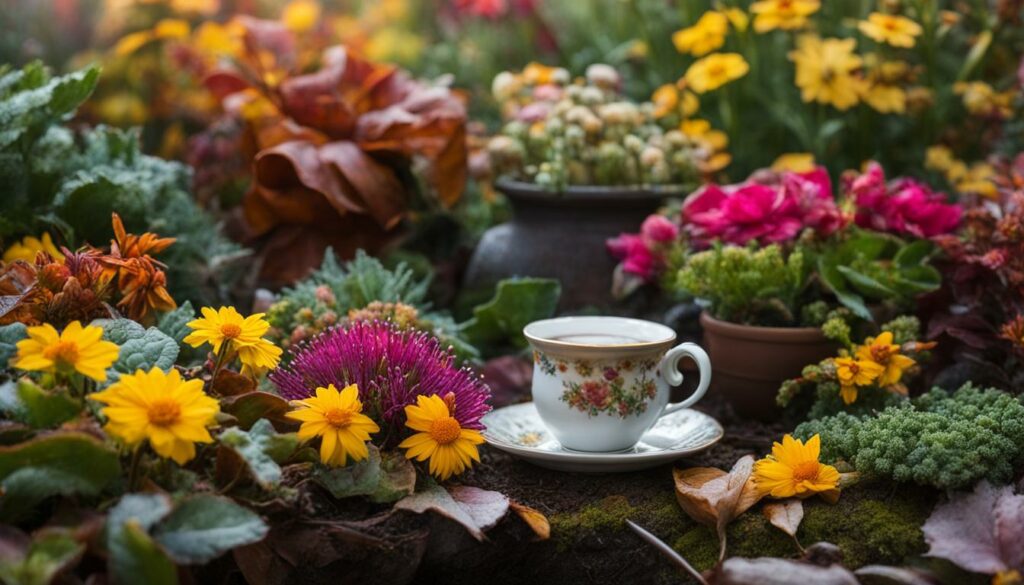
Water Your Plants Carefully
Be careful not to overwater your plants in the fall. Too much water can freeze and damage the roots of your plants. Instead, water your plants early in the day so they have time to dry off before the temperatures drop at night.
Bring Your Plants Indoors
If you have potted plants, bring them indoors when the temperatures drop. Place them in a sunny area and be sure to water them regularly.
Prune Your Plants
Pruning your plants before the temperatures drop can help them survive the colder months. Cut back any dead or damaged branches and remove any leaves or debris that may have accumulated around the base of your plants. This will help prevent disease and ensure that your plants have the best chance of surviving the winter.
By taking these steps to protect your plants from frost and cold, you can maintain your garden in the fall and ensure that your plants survive the colder months. Remember, a little bit of care goes a long way when it comes to fall garden care.
Pruning and Dividing Perennials
As the fall season approaches, it’s essential to start preparing your garden for the cooler weather. One important task is pruning and dividing your perennial plants. Not only will this promote their overall health and vigor, but it will also ensure they come back stronger next year. Here are some tips to get you started:
Pruning Perennials
Pruning perennials is important to remove any dead or diseased plants, encourage new growth, and tidy up the garden. Here are some steps to follow:
- Use clean, sharp pruning shears to make clean cuts and minimize damage to the plant.
- Trim back any dead or yellow leaves, cutting them off at the base of the stem.
- Cut back plant stems to about 2-3 inches above the soil line.
- Remove any dead flowers or seed heads to encourage new bloom growth.
- Once you’ve finished pruning, dispose of any plant debris to prevent the spread of disease.
Dividing Perennials
Dividing perennials will not only help control their size but also create new plants that can be spread throughout your garden. Here’s how to do it:
- Choose a cool, cloudy day to divide perennials.
- Dig up the entire plant, being careful not to damage the roots.
- Using a sharp knife, divide the plant into sections, making sure each section has both roots and foliage.
- Discard any diseased or damaged sections.
- Replant the sections in well-prepared soil and water thoroughly. Space the divided sections out, leaving plenty of room for growth.
By pruning and dividing your perennials in the fall, you’ll help ensure their health and growth for the following year. Plus, you can spread the love throughout your garden!
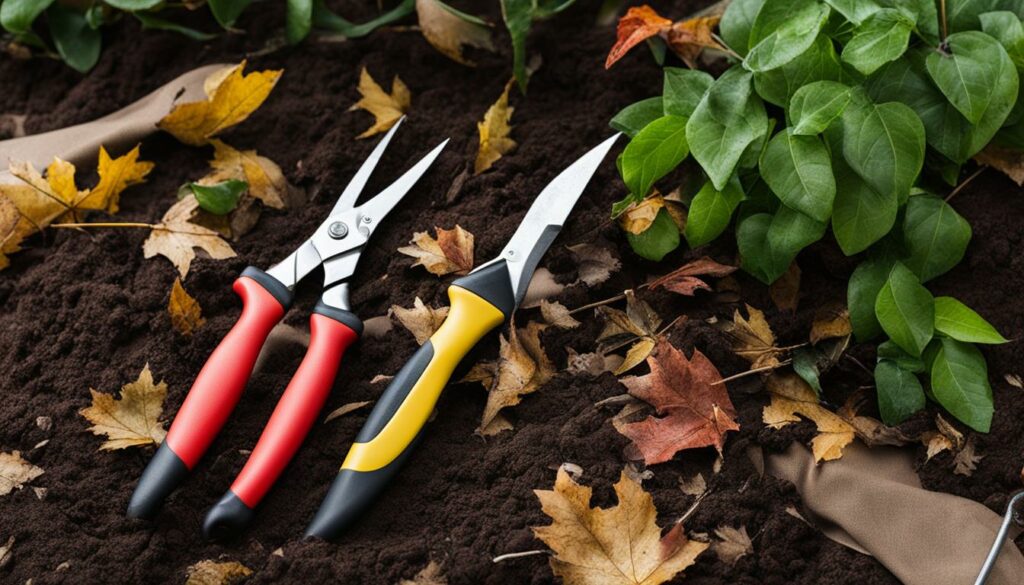
“Dividing perennials will not only help control their size but also create new plants that can be spread throughout your garden.”
Extending the Harvest with Fall Vegetable Gardening
Fall isn’t just for flowers; it’s also a great time to grow vegetables. In fact, some vegetables are better suited to the cooler temperatures of autumn than the heat of summer. Here are some fall gardening tips to help you extend your harvest:
Selecting Fall Vegetables
When selecting vegetables for fall planting, it’s important to choose varieties that can withstand cooler temperatures and shorter daylight hours. Some great options include:
- Broccoli: This cool-season crop can be planted in late summer for a fall harvest.
- Carrots: Plant carrots in late summer and harvest them throughout the fall.
- Lettuce: This leafy green is perfect for fall salads and can be grown in containers on a sunny patio.
- Spinach: Spinach thrives in cool weather and can be planted in late summer for a fall harvest.
- Cauliflower: Plant cauliflower in late summer for a fall harvest. Choose varieties that mature quickly, such as ‘Snowball’.
Preparing for Fall Planting
Preparing your garden for fall planting is similar to preparing for spring planting. Start by clearing away any summer debris and weeds. Make sure to loosen the soil and add compost or other organic matter to improve fertility and drainage. If the soil is dry, water it well before planting.
Planting Fall Vegetables
When planting fall vegetables, it’s important to plant them early enough so they have time to mature before the first frost. Use a planting guide for your area to determine the best planting dates for each crop. It’s also a good idea to cover your crops with a row cover or cold frame to protect them from early frosts.
Fall Vegetable Care
Once your fall vegetables are planted, it’s important to care for them properly to ensure a bountiful harvest. Keep the soil moist and add a layer of mulch around the plants to help retain moisture and regulate soil temperature. Fertilize your vegetables regularly with a balanced fertilizer to encourage healthy growth.
Harvesting Fall Vegetables
Harvesting fall vegetables is one of the most satisfying parts of fall gardening. Be sure to harvest your vegetables regularly to encourage continued production. Some vegetables, such as kale and Brussels sprouts, actually taste better after a light frost. Use a sharp knife or scissors to harvest your veggies, and enjoy the delicious flavors of fall!

“Fall isn’t just for flowers; it’s also a great time to grow vegetables.”
Caring for Your Lawn in the Fall
Maintaining your lawn during the fall is crucial to ensure a healthy, green landscape all year round. Here are my top fall lawn care tips:
- Continue mowing your lawn regularly, but adjust the height of the mower blade to keep the grass longer. This will allow it to absorb more sunlight and nutrients during the shorter days of fall.
- Fertilize your lawn in early fall. Look for a fertilizer specifically designed for fall application and follow the instructions carefully. This will provide your lawn with the necessary nutrients to stay healthy throughout the cooler months.
- Rake up fallen leaves on your lawn to prevent them from suffocating the grass and creating fungal disease. You can also use a mulching mower to shred the leaves and leave them on the lawn as natural fertilizer.
- Aerate your lawn to improve soil drainage and allow air, water, and nutrients to reach the grass roots. You can use a manual or mechanical aerator, or hire a professional lawn care service to do it for you.
- Protect your lawn from frost and cold temperatures by avoiding foot traffic on frosty mornings and covering the grass with blankets or tarps during a freeze.
- Check your lawn for any signs of pests or disease and take appropriate measures to control them. You can use natural remedies or seek advice from a lawn care specialist.
- Finally, continue to water your lawn regularly, but adjust the frequency based on the weather conditions. Cooler temperatures and more rain may mean you need to water less often.
By following these fall lawn care tips, you can ensure your lawn stays healthy and green throughout the autumn months.
Mulching and Protecting Garden Beds
As the fall season approaches, it’s important to take measures to protect your garden beds. Mulching and protecting your garden beds can help to maintain the health of your plants and ensure they survive the colder temperatures. Here are some gardening tips for fall to keep your garden beds protected:
- Remove weeds: Before you start mulching, it’s important to remove any weeds from your garden bed. Weeds can compete with your plants for nutrients and water, and they can also harbor pests and diseases.
- Apply a layer of mulch: A layer of mulch can help to insulate your plants, protect their roots, and prevent soil erosion. Apply a layer of mulch 2-3 inches deep around your plants, making sure to leave a gap around the plant stem to prevent rot.
- Use the right type of mulch: There are many types of mulch to choose from, including leaves, straw, wood chips, and shredded bark. Choose a mulch that is appropriate for your plants and the climate in your area.
- Protect plants from frost: In addition to mulching, you can also protect your plants from frost by covering them with frost blankets or burlap. Cover your plants in the evening before the temperature drops and remove the cover during the day to let them breathe.
- Water your plants: Even though the temperatures are cooler in the fall, your plants still need water to survive. Make sure to water your plants regularly, especially if there hasn’t been much rainfall.
- Remove fallen leaves: While leaves can make great mulch, a thick layer of leaves can also smother your plants and prevent them from getting enough sunlight. It’s important to remove fallen leaves from your garden bed regularly.
- Protect against pests: In the fall, many pests start searching for shelter from the cold. Protect your plants by removing any dead or dying foliage, which can attract pests. You can also use organic pest control methods, such as neem oil or insecticidal soap.
Following these fall gardening tips can help to protect your garden beds and keep your plants healthy throughout the season. Remember to choose the right type of mulch, water your plants regularly, and protect them from frost and pests. With a little bit of care, you can enjoy a beautiful and healthy garden all season long.
Enjoying Fall Colors and Lasting Beauty
As the weather turns cooler, the leaves on trees and shrubs begin to change color, offering a stunning display of autumn beauty. Incorporating fall colors into your garden is a great way to celebrate the season and enjoy lasting beauty throughout the fall months.
One way to add fall colors to your garden is by planting trees and shrubs that offer vibrant foliage. Some of my favorite options include:
| Plant | Foliage Color |
|---|---|
| Maple | Red, Orange, or Yellow |
| Dogwood | Purple, Red, or Orange |
| Black Gum | Scarlet or Purple |
Another way to incorporate fall colors into your garden is by planting fall-blooming flowers. Some of my favorites include chrysanthemums, asters, and sedum. These flowers offer a range of colors, from rich oranges and yellows to deep reds and purples.
If you’re looking for an easy way to add some fall color to your garden, consider incorporating seasonal décor. Pumpkins, gourds, and bales of hay can all add a touch of autumn charm to your outdoor space.
Remember, fall gardening isn’t just about preparing your garden for winter; it’s also about enjoying the beauty of the season. By incorporating fall colors into your landscape, you can create a stunning outdoor space that celebrates the best of autumn.
Conclusion
As fall approaches, it’s time to start preparing your garden for the coming season. By following these gardening tips for fall, you can ensure the health and beauty of your garden throughout the cooler months.
Stay Ahead of the Game
Remember to assess your garden’s needs, clean up summer debris, and select the right plants for fall. You can also extend your harvest by planting fall vegetables and caring for your lawn properly. Protecting your plants from frost and cold temperatures is essential, as is mulching and protecting your garden beds.
Add a Touch of Beauty
Don’t forget about the aesthetic appeal of fall, either! Adding fall colors to your garden can enhance its beauty and provide lasting enjoyment. With these tips in mind, you’re ready to tackle fall gardening with confidence and create a stunning autumn landscape.
Happy Fall Gardening!
FAQ
What are some gardening tips for fall?
Some gardening tips for fall include assessing your garden’s needs, cleaning up summer debris, planting fall bulbs, choosing the right plants for fall, protecting your plants from frost and cold, pruning and dividing perennials, extending the harvest with fall vegetable gardening, caring for your lawn in the fall, mulching and protecting garden beds, and enjoying fall colors and lasting beauty.
How do I assess my garden’s needs for fall?
To assess your garden’s needs for fall, take a look at your plants and identify any areas that need attention. Consider factors such as soil quality, plant health, and potential hazards. This evaluation will help you determine the necessary steps to prepare your garden for the upcoming season.
How do I clean up summer debris from my garden?
Cleaning up summer debris involves removing dead plants, fallen leaves, and any other organic waste from your garden. This helps prevent the spread of diseases and pests, as well as prepares the soil for planting new autumn flowers or vegetables. Dispose of the debris responsibly or consider composting it for future use.
What are some tips for planting fall bulbs?
When planting fall bulbs, choose bulbs that are suitable for your climate and garden conditions. Prepare the soil by loosening it and adding compost or organic matter. Dig holes at the appropriate depth for each type of bulb and place them in the ground with the pointed end facing up. Water the bulbs thoroughly after planting to settle the soil.
How do I choose the right plants for fall?
When selecting plants for fall, consider their hardiness and tolerance to cooler temperatures. Look for plants that are known to thrive in autumn conditions, such as certain varieties of asters, chrysanthemums, and ornamental grasses. Pay attention to the specific needs and growing requirements of each plant to ensure successful growth.
How can I protect my plants from frost and cold?
To protect your plants from frost and cold temperatures, you can use techniques such as covering them with blankets or frost cloth, applying a layer of mulch around the base, or moving potted plants indoors or to a sheltered area. Also, avoid overwatering your plants during cooler months, as excess moisture can lead to frost damage.
How do I prune and divide perennials in the fall?
Pruning and dividing perennials in the fall is beneficial for their overall health and growth. Start by trimming back any dead or damaged foliage. For dividing, carefully dig up the plant and separate it into smaller clumps, ensuring each division has sufficient roots. Replant the divisions in desired locations, and water them well.
What are some tips for fall vegetable gardening?
To engage in fall vegetable gardening, choose crops that are cold-tolerant and have shorter growing seasons. Prepare the soil by adding compost or organic matter, and sow the seeds according to the specific requirements of each vegetable. Water regularly and protect your crops from pests and frost as necessary.
How do I care for my lawn in the fall?
Caring for your lawn in the fall involves regular mowing, fertilizing with a fall-specific fertilizer, and raking up fallen leaves to prevent suffocation. Adjust your mower’s cutting height and continue watering as needed. Additionally, address any weed or pest issues that may arise to maintain a healthy and vibrant lawn.
How do I mulch and protect my garden beds in the fall?
To effectively mulch and protect your garden beds in the fall, apply a layer of mulch around the base of your plants to insulate the soil and inhibit weed growth. You can use organic materials such as straw, leaves, or wood chips. Additionally, consider using protective covers or wraps for more delicate plants.
How can I incorporate fall colors into my garden?
To enjoy fall colors and lasting beauty in your garden, consider planting trees, shrubs, and perennials that showcase vibrant autumnal hues. Some popular options include maples, oakleaf hydrangeas, and ornamental grasses. You can also add seasonal decor, such as pumpkins and gourds, to enhance the fall atmosphere.


